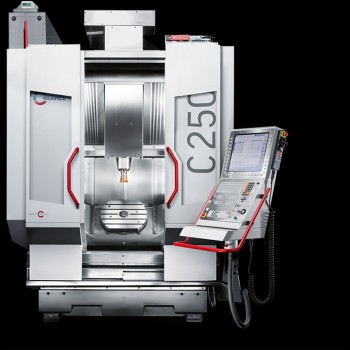C 250 – Hermles entry level model into 5-axis / 5-sided machining

Photo by Maschinenfabrik Berthold Hermle AG
Within the Hermle range of models, the C 250 is an entry-level model into the world of 5-axis & 5-sided machining. Nevertheless, its no way inferior compared to the “large” models . Thanks to the large swivelling range of the workpieces in the working area, the utilisation of the complete traverse range and the large collision circle between the table side walls, the C 250 offers the largest working area propotional to the installation area.
The C 250 is designed for daily use – maximum user-friendliness thanks to pivotable control panel and minimum table distance from the operator and optimum loading height with option ofloading by crane. The spindle moves into the magazine and there is a completely free access to the working area, when loaded by crane. This can be done without restriction from above to over the centre of the table.
5-axis milling thanks to the latest drive technology
Maximum precision thanks to the Hermle swivelling rotary table concept. The machining table has a large worm drive. On the A axis you can directly access the gearwheel on the table housing. This enables quick and above all high-precision positioning of the workpieces without shaft torsion on the machining table. The table variants of the C 250 therefore stand for the highest quality and optimum use of material – from the cast housing to the installed gear motors: Made in Germany – made in Gosheim.
High-tech tool spindles with collision protection
Like the swivelling rotary tables, the tool spindles are also completely manufactured in-house at the Gosheim site. The slimline tool spindles are constructed in two parts and can be replaced easily and quickly during servicing. Thanks to low interfering edges and collision protection by
compression sleeves, safety is given primary importance by maximum collision avoidance. Damage can be prevented in 50 % of collisions.
News Categories
- » NEWS HOME
- » Automation & Robotics
- » Industry 4.0
- » Material Handling
- » Sensors
- » Quality & Testing
- » Machine Vision
- » Laser & Optics
- » Metalworking
- » Motion Control & Drives
- » Hydraulics & Pneumatics
- » Process Industry
- » Renewable Energy
- » Agriculture
- » Home & Office Furniture
- » Environmental Tech




